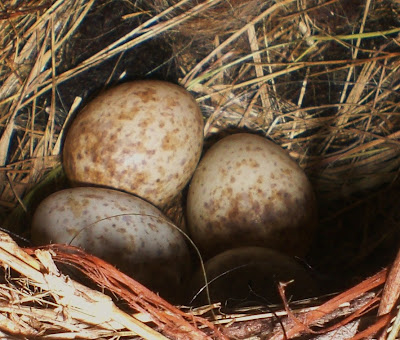One site had no sign of shrikes at all, but at the other site, just as I was about to leave thinking those birds were gone too, I saw a shrike light on telephone wire where I have seen the adults hunt. I quickly got out my spotting scope to see if it was the adult bird I had tagged for the purpose of monitoring its movements, but was happy to see that it was one of the juveniles from the adult pair's previous clutch.
No doubt this bird was one of the two that I have seen begging for food from the adults in some of my previous visits to this spot. When I left for Tall Timbers last week, this bird was not hunting for itself and relied on the good graces of it's parents for nourishment to keep it alive, but now it was actively hunting on it's own, snatching grasshoppers out of the air; curiously eyeballing deft barn swallows as they swooped in to investigate the tiny raptor.
I watched this hatch-year bird for an hour in the hopes that it's parents or sibling would join him/her, but to no avail. Since their second nests failed, did the adults disperse to another location? What about the juvenile? Did he relocate as well?
I'd like to think that is all that happened; the birds just moved to greener pastures, but the pessimist in me tells me they are dead. This, realistically, could be the case. This would mean that this lone juvenile is the survivor.
Part of me wants me to trap this juvenile, put a radio tag on him, and see where it goes. Will it stay in this area since the parents are gone? I mean, at least one successful brood was raised in this habitat.
As I watched the once incapable and now lonely bird hunt, I think that I will opt to not harass him. What if he injures himself in the trap? What if the color bands I put on him attracts a predator? What if his band get tangled in a mess of thorns? It hasn't happened to any birds I have banded to my knowledge, but what if it happens to him? I started to think of a million things that could go wrong and soon I became overwhelmed.
At that point I could never think of touching that bird. I began to think that just by watching him he might erupt in a burst of flames and it would, of course, be my fault.
No, I will not mess with this bird, but I will come back to see if he's still around knowing that some time soon, I will arrive at the site and he will be gone. Then, I will silence the pessimist and imagine this bird raising a next generation of shrikes.

Shrike nest with eggs

Same nest abandoned (bottle cap for scale)

I didn't get a picture of the juvenile bird... but here's some nestlings from Tall Timbers!


sweet
ReplyDeletehttp://www.birdmad.com/